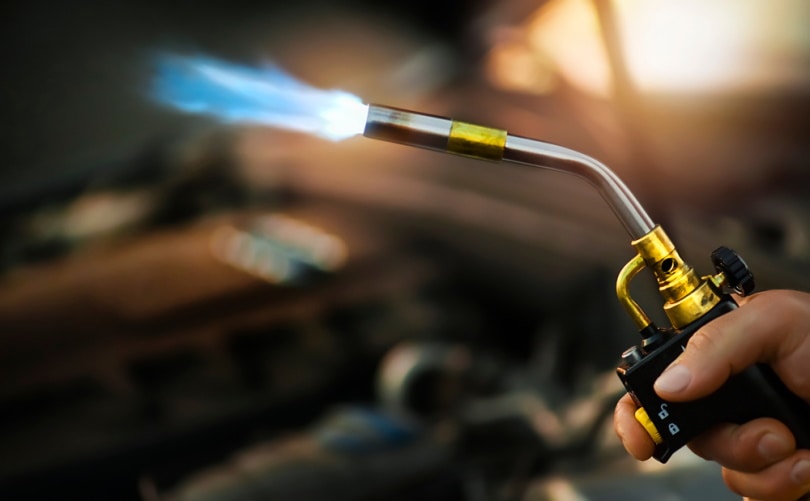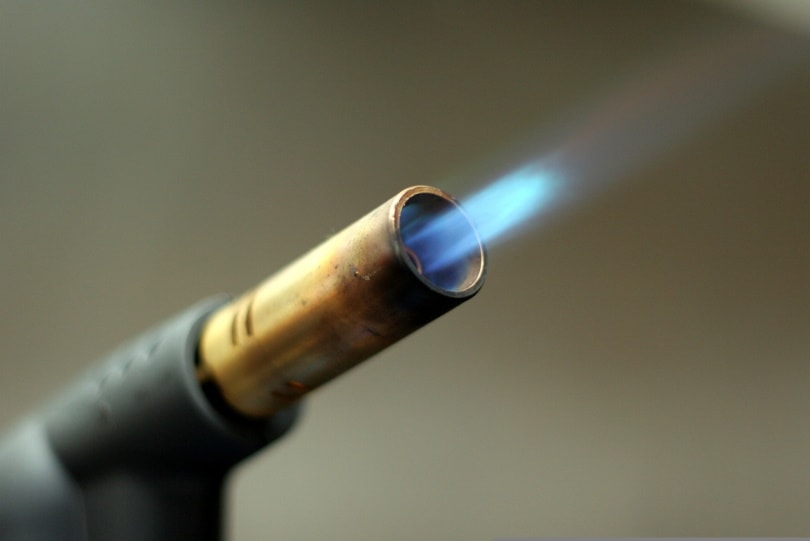How Hot Does a Propane Torch Get? Uses, Tips, & FAQ
-
Codee Chessher
- Last updated:

Propane torches are a staple of several industries, including welding, glassblowing, and cooking. They can be used to loosen old paint, solder copper pipes, and numerous other applications that make them a handy piece of equipment for any DIY enthusiast. Propane is also used as a fuel for grills, water heaters, and other appliances. Exactly how hot does a propane torch get?
Propane torches reach a maximum temperature¹ of 3,623 degrees Fahrenheit, or 1,995 degrees Celsius. Some oxygen-fed propane torches can achieve even higher temperatures. However, you must have an oxygen-fed fuel mixture to achieve higher temperatures, with typical propane tanks only reaching about 2,250 degrees Fahrenheit (1,250 degrees Celsius).

Propane Torch Heat & Gas
Overall, the hottest point of a propane torch is the tip of the darker inner flame, while the lighter outer flame is slightly cooler. The low boiling point of propane makes it usable in freezing conditions, unlike butane.
Propane itself is a colorless and odorless gas derived from petroleum products, but typically a chemical odor is added to make gas leaks easier to detect. Tanks range in size from small portable canisters intended for camping stoves to large upright cylinders that feed household kitchens. The high temperature of burning propane makes it a great fuel, with a higher temperature than butane.

Uses of Propane Torches
We highlighted some of the main applications of propane torches above, but there are many more that would probably surprise you. Let’s check out a few more below.
- Making specialty desserts
- Unsticking stubborn nuts and bolts
- Stripping paint
- Incinerating weeds
- Soldering copper, wire, and other metals
- Blowing glass
- Annealing
- Roofing
- Brazing
- Melting snow or ice
- Woodworking

How Hot Do Other Types of Torches Get?
Propane may be the most popular fuel for torches, but it’s not the only one, or even the hottest. By using other fuels, you can customize the heat level to suit the task. Let’s check out some other types of torches and how hot they get.
- MAPP torches: 5,300 degrees Fahrenheit (2,925 degrees Fahrenheit)
- Oxy-acetylene torches: 6,300 degrees Fahrenheit (3,480 degrees Celsius)
- Butane torches: 2,610 degrees Fahrenheit (1,432 degrees Celsius)
- Propylene torches: 2,896 degrees Fahrenheit (1,591 degrees Celsius)
Are Propane Torches Good for Welding?

Unfortunately, propane torches don’t get hot enough to make them suitable for fusion welding metals like steel. However, sometimes propane torches are used to preheat work pieces in preparation for welding with oxy-acetylene or propylene torches.
One other important reason propane isn’t suitable for welding is that it doesn’t create a reducing zone like oxy-acetylene torches. When that torch is used with oxygen, it will clean a metal surface and improve the resulting weld.
The major caveat is that propane can be used to melt and bond some metals with lower melting points. These include copper, platinum, silver, and zinc. While propane isn’t ideal for welding any metal, it’ll work in a pinch. You’ll simply have to clean the metals very well before attempting to weld.

Conclusion
Propane torches are a very handy tool to have around, useful for clearing weeds in driveways, soldering copper, and more. While they’re not the hottest type of torch around, they’re definitely the most widely available. The tanks are also typically interchangeable with other propane appliances, making them versatile.
Featured Image Credit: Krasula, Shutterstock
Contents

